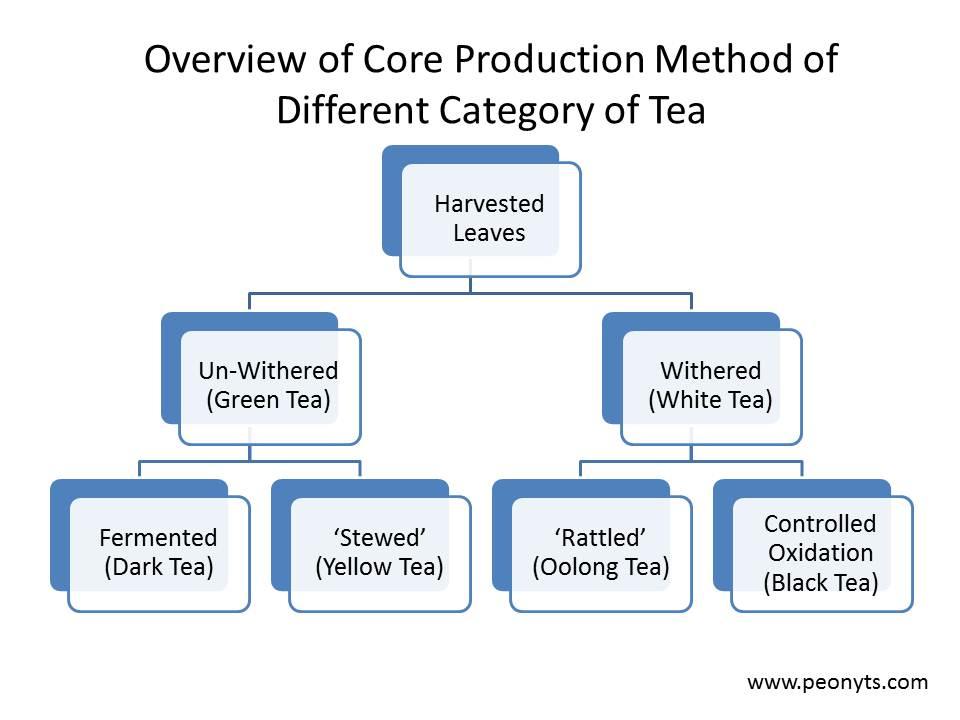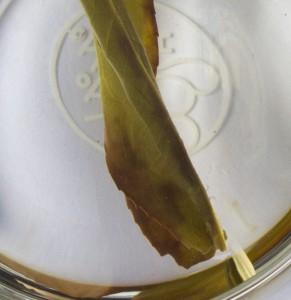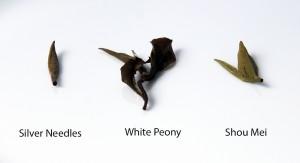This article is part of a series where we answer frequently posed questions when we interact with you at events and roadshows.
Interestingly enough, some variation of “What does this type of Tea do?” or “What health benefits does this tea have?” are very common questions.
Before we dwell into the specifics of each type of tea, let us examine the factors that affects the chemical content and hence health implications of each type of tea.
Production Method

The diagram shows the core or defining production technique of various types of tea.
How this impacts the chemical composition of tea is primarily in the oxidation and/or fermentation of the tea (do note that they are different as outlined here).
In summary:
Green Tea:
Heated shortly in a process known as ‘shaqing’ (杀青) after harvesting (particularly for high grade Chinese greens) to destroy the enzymes that causes oxidation.
Hence green teas are considered un-oxidized (or substantially un-oxidized teas).
Process overview-
‘Shaqing’-> Rolling/Shaping -> Drying (Either sunning, steaming, wok-roasting or baking)
Yellow Tea:
Production of yellow tea is very similar to that of green tea but with an additional step known as ‘menhuang’ (闷黄) or literally ‘stewing till its yellow’.
Process overview
‘Shaqing’-> ‘Stewing’-> Rolling/Shaping -> Drying
*Note depending on the style of the area, ‘stewing’ can take place before or after rolling.
Dark Tea:
Dark tea undergoes a step known as ‘wodui’ (渥堆) where water is added to the leaves in a hot and humid controlled environment to induce fermentation.
Naturally fermentation radically alters the chemical composition of the leaves.
Process overview (maocha)
‘Shaqing’->Shaping->Fermentation->Drying
White Tea
White teas are withered to let it oxidize naturally. Hence white teas are lightly oxidized.
Process overview:
Withering-> Drying (Sunning or Baking)
Oolong Tea

The leaves are rattled to cause bruising which expedites the oxidation. Depending on the style of the producer, the rattling may be repeated or the withering time varied to vary the oxidation levels.
The photo shows some reddish hues on the sides while the inner areas are still greenish to reflect this.
Process overview:
Withering->Rattling->Shaqing->Shaping->Drying
Black Tea
Black teas undergo a process known as ‘wohong’ 渥红 or traditionally (but erroneously) known as ‘fermentation’ to oxidize the teas to 90% and above.
Hence the chemical composition of tea leaves alters most radically in black tea.
Process overview:
Withering->Shaping->Wohong->Drying
In addition, the individual processes come into play.
For example heat has the effect of destroying certain chemicals- such as caffeine which melts at 230⁰C. Hence production of certain types of green teas and oolongs which employ heats of that level would affect the caffeine content.
However this is too specific for an overview like this.
Picking Requirements
Picking requirements is also an important determinant of the chemical content.
For example: all else being equal, buds have a higher content of amino acid.
Hence you would expect Silver Needles which are entirely made from buds to have much higher amino acid than say Puer which is made from matured leaves.
To recap here’s an overview of the general picking requirements for each category of tea:
Green Tea
- 1 bud to 1-2 leaves
- Notably Liuan Guapian is made from leaves only
Yellow Tea
- Similar to green tea
White Tea

- White Peony (1 bud to 1-2 leaves)
- Shou Mei (whatever is left)
Oolong
- Generally 2-3 leaves on each stalk
Dark Tea
- 3-4 leaves
Black Tea
- Historically 1 bud to 2 leaves
- However with increasing commercial yields, China has more and more 1 bud to 1 leaf black teas emerging
Picking Seasons
In general, spring teas are the most valued since they accumulate the nutrients that the plant has accumulated while in hibernation during winter.
In contrast, the tea plant buds faster during summer because of the heat. As such, it accumulates far less nutrients and this can be reflected in the higher astringency (lack of amino acid).
Elevation
Elevation affects the chemical composition of tea similar to the picking season because of heat and mist.
Partially shading from sunlight has the effect of delaying growth in the plants which allows it to accumulate more amino acid- among other nutrients- which explains why gyokuro plants are shaded for 2-3 weeks to delay the harvest and accumulate more nutrients.
Cultivar
Cultivar in essence is a sub-species of the tea plant that exhibits certain characteristics. (See here for more on cultivar)
Taking an example to illustrate:
Mengku Dayecha cultivar (C sinensis var assamica CV. Mengku –dayecha)
A spring picking of 1 bud to 2 leaves has on average:
Amino acid: 1.7%
Polyphenols: 33.8%
Catechins: 18.2%
Caffeine: 4.1%
Compared with
Fuding Dabaicha cultivar (C. sinensis CV. Fuding-dabaicha)
Amino acid: 4.3%
Polyphenols: 16.2%
Catechins: 11.4%
Caffeine: 4.4%
(source: Cha Xue Gai Lun by Zhou Ju Gen et al)
In short, an understanding of these factors and the impact it has on the chemical composition of the finished tea will aid us in answering the question of the differing health benefits of each type of tea.
That naturally is something for a later post.
See here for other frequently asked tea related questions
See here for more articles related to tea and health
